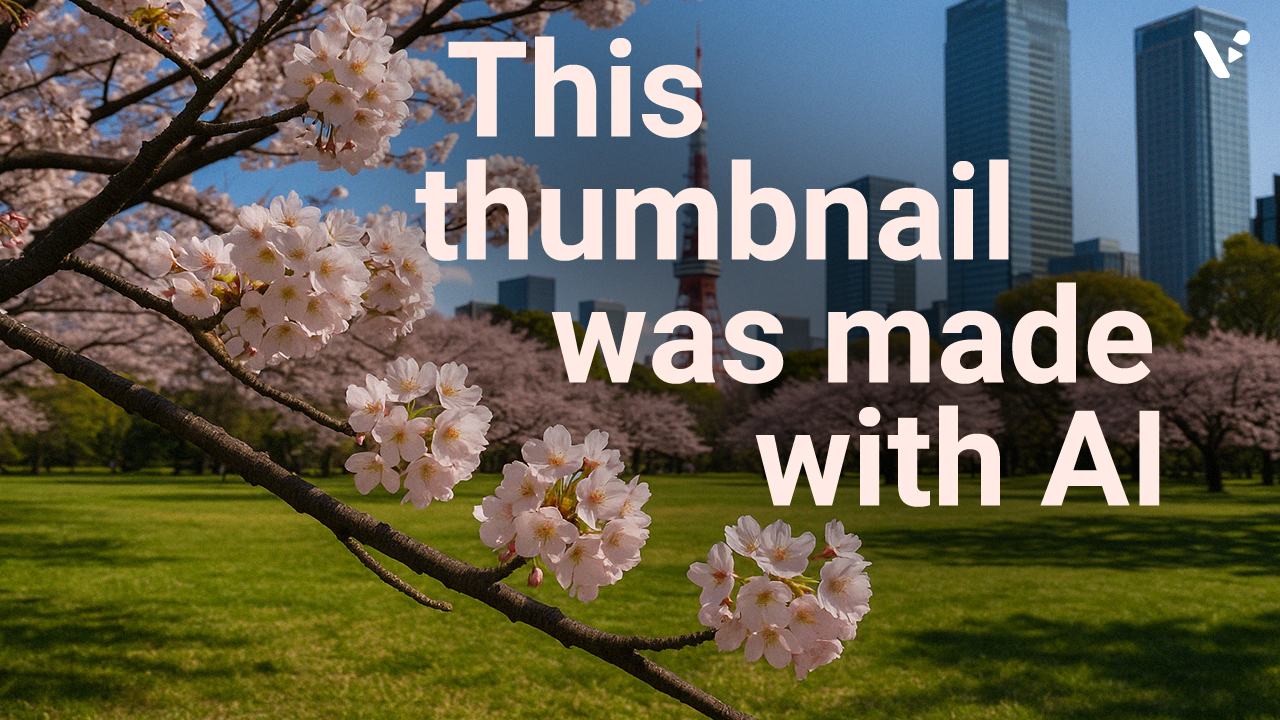AI visuals are everywhere. You see sleek renders in ads, looping backgrounds in product demos, and quick b‑roll that smooths over edits. That raises a fair question for creators and teams: should you add AI‑generated images or video to your next project? Short answer: yes, you can. Use it with intention. Choose high‑quality generation. Keep it simple. Rely on AI for support, not spectacle.
Quick answer:
Yes, use AI‑generated visuals as support when they save time and look natural. Keep prompts simple. Choose high‑quality, brand‑safe generators like Adobe Firefly. Use short clips as b‑roll and Visla’s AI wallpaper for clean backgrounds.
Key takeaways
- Keep it simple: backgrounds and subtle motion work best.
- Avoid uncanny results: pick high‑quality, permissioned tools.
- Treat AI clips as b‑roll, not the hero.
- Use Visla’s AI wallpaper for scenes without b‑roll or behind avatars.
- If you generate a clip elsewhere, upload it to Visla to edit, brand, and share.
What is AI image generation?
In one line: AI image generation creates still pictures from text prompts; use it for simple, straightforward assets.

AI image generation uses models that create new pictures from short prompts. You type what you want. The system synthesizes a still image that matches your description. You might request a clean, abstract pattern for a title card, a soft gradient backdrop for a talking head, or a simple object on a white sweep for a cutaway. The results arrive in seconds. You can adjust the prompt and try again until you land on a usable frame.
You do not need to understand the math to get value here. The key idea is control. You can steer style, color, and subject with a few clear words. You can also generate several safe options and choose the one that feels natural in your edit. For teams that need consistent presentation assets, this can save hours of scouting or setup.
One more point matters: the data used to train the generator. Some models learned from images scraped from the web without permission. If you work for a brand or with clients, that can raise real legal and ethical questions. Prefer tools that train on licensed or permissioned sources. Adobe Firefly, for example, focuses on licensed training data. That approach better supports brand safety and peace of mind.
What Is AI Video Generation?
In one line: AI video generation turns short prompts into a few seconds of motion; keep requests basic so results feel natural.
AI video generation creates short motion clips from text prompts. Think simple visuals that feel like b‑roll: a slow pan across a city skyline at dusk, a macro shot of raindrops on glass, or a looping background of floating particles. The most talked‑about systems can turn a one‑sentence prompt into a few seconds of motion. We are talking about the Sora or Veo style of technology, not editing tools.
This capability can help you fill gaps. It can round out a montage. It can sit behind on‑screen text or a talking head. Treated as support, not the star, it can look natural and help your story flow.
The uncanny valley is real. Overreach and the clip can distract. Ask for basic motion and you will get better results. If you need highly specific or narrative footage, you still shoot it yourself or license stock from a reputable library.
Should you use AI‑generated visuals?
You should use AI‑generated visuals when they help the message and save time. You should avoid them when they compete with your core footage or when you cannot meet brand or legal standards. Use common sense. Keep the bar high.
Pros
- Speed for simple assets. You can spin up backgrounds, textures, or basic product cutaways in minutes. That removes small roadblocks that stall edits.
- Cost control for filler moments. When you need five seconds of generic atmosphere, generation can be more efficient than a custom shoot.
- Style consistency. You can prompt for the same color palette and mood across a set of scenes. That gives you a tidy, cohesive look.
- Creative exploration. You can try ten variations quickly. That helps you test ideas without committing to a full production path.
Cons
- Quality variance. Not every model can hold up under scrutiny. Artifacts or odd motion can break immersion. Viewers notice.
- Ethical and legal risk. Models trained on unlicensed data may introduce brand risk. Favor tools with permissioned training to protect your team and clients.
- Mismatch with reality. Ask for something far‑fetched and it will look far‑fetched. If the scene feels off, trust your instincts and cut it.
- Overuse fatigue. A timeline packed with synthetic visuals can feel generic. Your audience craves real people, real stories, and real product proof.
Practical guardrails that really work
Follow these guidelines to stay safely on track.
- Keep it simple. Use the KISS rule. Ask for basic subjects and gentle motion. Think soft gradients, abstract shapes, subtle parallax, slow pans, or ambient textures.
- Use high‑quality generators. Choose tools known for clean results and permissioned training data. Adobe Firefly is a solid option when brand safety is top priority.
- Limit duration. Treat generated clips like b‑roll. Use them for five to eight seconds to bridge edits or underscore a point.
- Match your brand. Prompt for your palette, type of light, and style adjectives. Save prompts so you can recreate the look later.
- Test on real screens. Preview on a phone, a laptop, and a TV. If anything feels uncanny, replace it with stock or your own footage.
- Respect context. Do not use AI visuals to imply an event that never happened. Keep the line between illustration and documentation clear.
How AI can help
Use AI where it makes your edit smoother without stealing focus. Inside Visla, you have two smart options.

Generate scene backgrounds with AI Wallpaper. Some scenes do not need literal footage. They need a clean, on‑brand canvas behind your message. Visla’s AI wallpaper generation gives you that canvas in seconds. You can:
- Let it work automatically. Let Visla suggest a background that fits the scene’s tone and text. This works well when you need fast filler between interview soundbites or product screenshots.
- Use a prompt. Describe the look you want and generate several options. Ask for a soft gradient in your brand colors, a minimal studio look with gentle vignetting, or an abstract texture that suggests motion.
Use AI wallpaper in two high‑impact spots:
- Scenes without b‑roll. When you have voiceover or on‑screen text but no matching footage, drop in a generated wallpaper so the timeline stays smooth.
- Behind an AI avatar. If you use an avatar to deliver lines, place a generated wallpaper behind it to keep the frame tidy and on brand.
Bring in AI‑generated clips, then finish in Visla. Visla does not offer the Sora or Veo style of prompt‑to‑video generation yet. If you create a short AI clip elsewhere, upload it to Visla and we’ll take it from there. You can use any clips uploaded to Visla in your video projects.
This approach keeps AI where it excels. It supports your story. It never overwhelms it.
AI prompt examples that work
Steal these starter prompts and tune the brand details to taste.
- Soft gradient backdrop: “Muted teal to deep navy gradient, clean studio background, subtle grain, gentle vignette, modern tech brand.”
- Abstract motion texture: “Slow flowing particles, shallow depth of field, soft bokeh, calm motion, minimal, cinematic, loopable.”
- Minimal product pedestal: “Matte white pedestal on seamless background, soft top light, faint shadow, high key, contemporary.”
- Calm city ambience: “Distant skyline at blue hour, slow push‑in, no people, light haze, understated mood.”
Keep the language simple. Specify mood, light, and pace. Avoid complex actions or busy scenes.
FAQ
Yes. Use AI visuals as support, not the star, and keep your prompts simple. Choose high‑quality generators trained on licensed data, such as Adobe Firefly, to reduce legal and ethical risk. Reserve AI clips for short b‑roll and clean backdrops. Do not use AI visuals to depict events that never happened.
AI b‑roll works best for simple backgrounds, abstract textures, light motion, and mood setters. Use it behind subtitles, product callouts, or a talking head to smooth cuts. Keep each clip short, usually five to eight seconds, so it feels natural. Avoid complex action or detailed human motion.
Look for tools that use licensed or permissioned training data and provide clear usage rights. Models like Adobe Firefly are designed for brand‑safe output. Review the provider’s licensing terms and any indemnification they offer. Keep records of your prompts and versions for compliance.
Follow the KISS rule and request basic subjects with gentle motion. Skip lifelike faces, hands, and fast action where artifacts stand out. Preview on multiple screens and watch for odd physics or texture flicker. If anything feels off, swap in stock or real footage.
Visla does not offer prompt to video yet in the sense that Sora and Veo both do. You can generate short AI clips elsewhere and upload them to Visla to trim, loop, caption, and brand inside our scene‑based editor. Use Visla’s AI Wallpaper to create on‑brand backgrounds automatically or with a quick prompt, perfect for scenes without b‑roll or behind an AI avatar. This workflow keeps AI as a helpful support while Visla handles creation, collaboration, and sharing.

